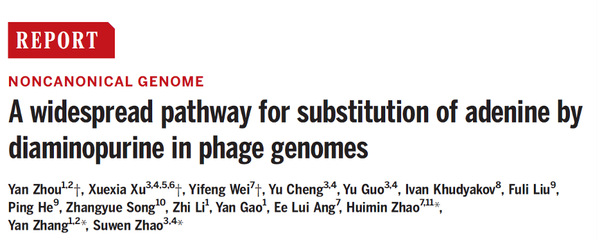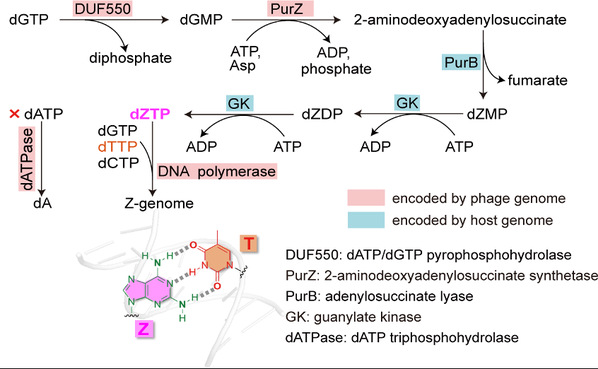Recently, Dr. Zhao Suwen’s team at the iHuman Institute, collaborating with other scientists from Tianjin University, and the Agency for Science, Technology and Research (A*STAR)/ University of Illinois at Urbana-Champaign (UIUC) have solved a long-standing mystery of Z genome that comprises entirely non-canonical Z-T base pairs instead of canonical A-T base pairs in bacteriophages (Figure 1). They discovered the key enzymes responsible for the synthesis of this non-canonical base pair in dozens of globally widespread phages and further verified the Z genome in one of these phages. This discovery enables the synthesis of Z-DNA on a large scale for a diverse range of applications ranging from phage therapy to synthetic biology to DNA storage. The research is published in Science, available online on April 30, 2021.


Figure 1. Z-T base pair has three hydrogen bonds, while A-T base pair only has two.
Zhao’s lab has been focused on developing computational methods to study protein sequence-structure-function relationships. The lab has two major research directions: one is GPCR mechanism study and ligand discovery, and the other is discovery of new enzyme functions, metabolic pathways, and metabolites. Dr. Zhao and her team have developed a series of computational methods to improve the accuracy and/or throughput of assigning reliable functions to enzymes discovered in various bacterial or viral genomes.
The laboratory of Dr. Zhang Yan at the School of Pharmaceutical Science and Technology, Tianjin University, has expertise in characterizing new enzymes and pathways through a combination of bioinformatic, genetic, biochemical and biophysical methods.
The laboratory of Dr. Zhao Huimin at A*STAR/UIUC develops and applies synthetic biology, machine learning, and laboratory automation tools to engineer functionally improved or novel proteins, pathways, and genomes for biotechnological and biomedical applications.
The team formed by researchers from these three labs is interested in predicting and validating functions of enzymes involved in phage DNA modifications. Phage DNA is often modified to evade digestion by host bacterial restriction enzymes. Among dozens of naturally occurring DNA modifications, most can be found in bacteriophages. Diamopurine (Z) is one of such cases. It was discovered in the genomic DNA of cyanophage S-2L more than 40 years ago. It replaces adenine (A) in the phage DNA entirely and forms three hydrogen bonds with thymine (T). However, the enzymes required for Z genome synthesis are not known.
The team applied in silico methods such as sequence similarity network analysis, protein structure prediction, genome context analysis, and enzyme mechanism study, combined with in vitro and in vivo experimental methods including various enzymatic assays, HPLC, LC-MS/MS and nanopore sequencing, to characterize the biosynthetic pathway responsible for Z genome synthesis in phages (Figure 2) and validate the Z genome in Acinetobacter phage SH-Ab 15497.

Figure 2. The characterized biosynthetic pathway of Z-genome in phage.
Ph.D. candidate Xu Xuexia from iHuman Institute, Ph.D. candidate Zhou Yan from Tianjin University and Dr. Wei Yifeng from A*STAR/UIUC are the co-first authors. Drs. Zhao Suwen, Zhao Huimin and Zhangyan are the co-corresponding authors. The Cloning Core of iHuman, the Biomedical Big Data Platform and Analytical Chemistry Platform at SIAIS also provided assistance for the research.

